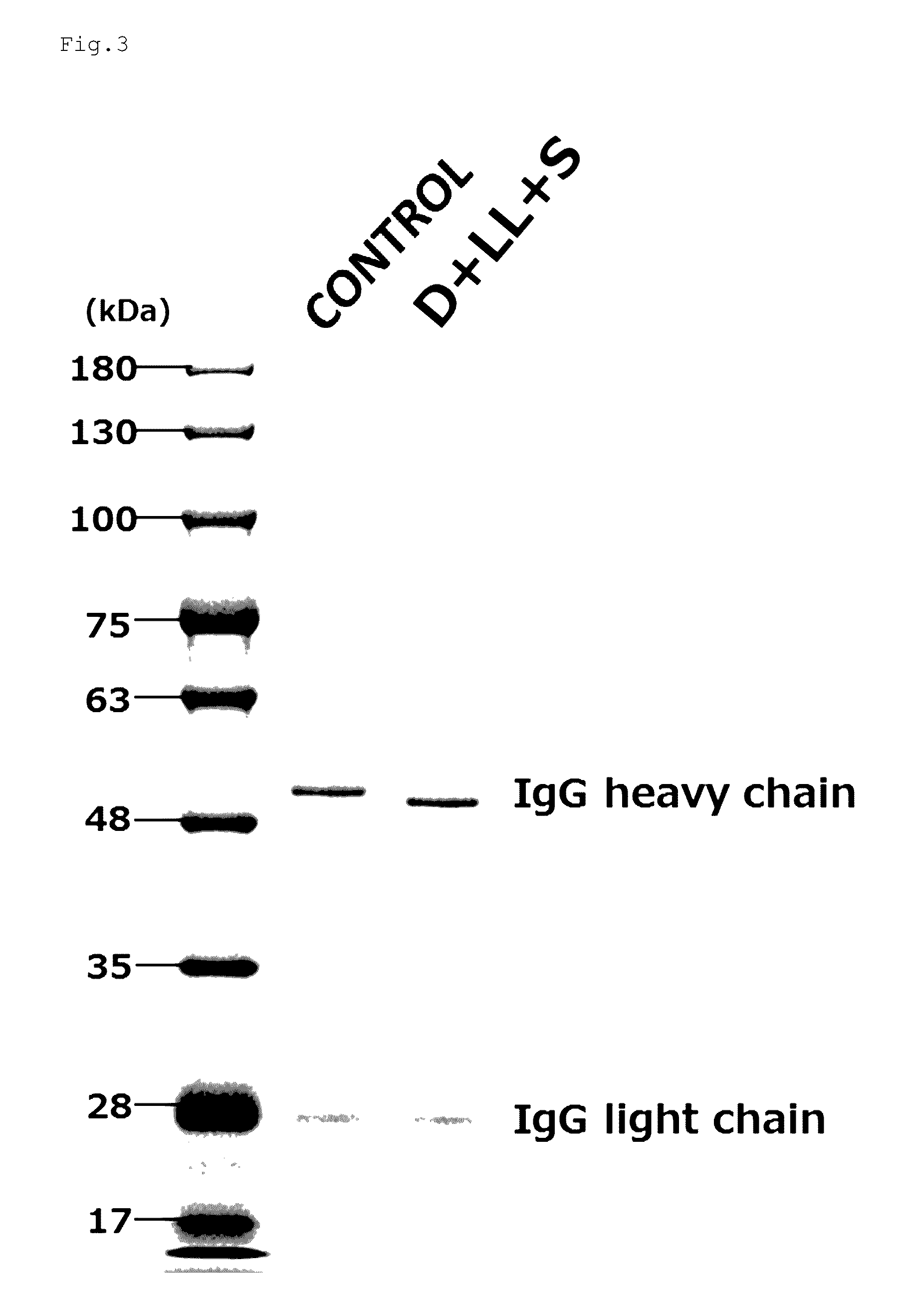Method for preparing glycan-hydrolyzed antibody, and homogeneous glycosylated antibody
a glycoprotein and glycan technology, applied in the direction of immunoglobulins, instruments, peptides, etc., can solve the problems of inability to precisely and quantitatively distinguish molecules, several glycosidases have not been attempted to improve hydrolysis efficiency, and the molecular weight of a detected protein is too large to achieve precise and quantitative differentiation of molecules, and achieve efficient preparation of acceptor antibodies , the effect of low cos
- Summary
- Abstract
- Description
- Claims
- Application Information
AI Technical Summary
Benefits of technology
Problems solved by technology
Method used
Image
Examples
example 1
Preparation of EndoLL
[0134]The amino acid sequence of Lactococcus lactis that produces a protein having an amino acid sequence showing high homology with a partial amino acid sequence of a known endo-β-N-acetylglucosaminidase was searched using NCBI blastp, and primers were then designed based on the corresponding genomic sequence. The primer sequences of sense and antisense primers are shown below.
[0135]
EndoLL-12F (sense primer)(SEQ ID NO: 3)5′ ttggaggattttatgaaaaaatcg 3′EndoLL stopR (antisense primer)(SEQ ID NO: 4)5′ tcagctatttttttgtcctaatacttg 3′
[0136]Using gDNA extracted from Lactococcus lactis (Accession No. MAFF516032) deposited in the National Institute of Agrobiological Sciences (2-1-2 Kannondai, Tsukuba, Ibaraki 305-8602, Japan) as a template, PCR was carried out with the aforementioned primers, and the amplified 2.8-kbps fragment was then separated and cleaved by 0.8% agarose gel electrophoresis. Thereafter, it was then purified using Wizard SV Gel...
example 2
Production of Mouse IgG1 by Silk Gland of Silkworm
(1) Production of Vector
[0143]The cDNAs of the heavy chain and light chain of mouse IgG1 were isolated from mouse hybridomas. Subsequently, PCR was carried out using primers comprising a 5′-untranslated region sequence of BmNPV polyhedrin (Japanese Patent Laid-Open No. 2008-125366), so that the 5′-untranslated region sequence of BmNPV polyhedrin could be added to the 5′-terminus of each of the heavy chain and light chain cDNAs. The obtained heavy chain cDNA of mouse IgG1 was inserted into the NruI site of a silkworm transformation vector pMSG3.1 MG (Japanese Patent Laid-Open No. 2012-182995), and thereafter, the light chain cDNA was inserted into an Eco47III site thereof, so as to complete a plasmid vector to be used for incorporation of mouse IgG1 cDNA into a silkworm.
(2) Production of Transgenic Silkworm
[0144]The above described plasmid vector was purified with Plasmid Midi Kit (QIAGEN), and it was then mixed with a helper plasmid ...
example 3
Preparation of Acceptor of Mouse IgG1 Produced from Silkworm Silk Gland by Simultaneous Hydrolysis with EndoS, EndoLL and EndoD, and Confirmation by SDS-PAGE
[0148]Mouse IgG1 (1 mg) produced by the silk gland of silkworms, and EndoS (2 μg), EndoLL (2 μg) and Remove-iT Endo-D ((NEB) 150 units) were added to a 50 mM sodium phosphate buffer solution (pH 7.5) to a total amount of 500 μl and the obtained mixture was then left at rest at 37° C. for 17 hours. To this reaction solution, 75 μl of Ab-Capcher ExTra (ProteNova Co., Ltd.) that had been equilibrated with a 50 mM sodium phosphate buffer solution (pH 7.5) was added, and the thus obtained mixture was then subjected to rotary shaking at room temperature for 3 hours, so that the antibody was captured on the gel carrier. The operation to wash the carrier with 450 μl of PBS for 5 minutes three times in total, and 150 μl of a 0.1 M glycine-HCl buffer solution (pH 2.7) was then added to the resulting carrier. The resulting solution was sha...
PUM
| Property | Measurement | Unit |
|---|---|---|
| concentration | aaaaa | aaaaa |
| pH | aaaaa | aaaaa |
| concentration | aaaaa | aaaaa |
Abstract
Description
Claims
Application Information
 Login to View More
Login to View More - R&D
- Intellectual Property
- Life Sciences
- Materials
- Tech Scout
- Unparalleled Data Quality
- Higher Quality Content
- 60% Fewer Hallucinations
Browse by: Latest US Patents, China's latest patents, Technical Efficacy Thesaurus, Application Domain, Technology Topic, Popular Technical Reports.
© 2025 PatSnap. All rights reserved.Legal|Privacy policy|Modern Slavery Act Transparency Statement|Sitemap|About US| Contact US: help@patsnap.com



